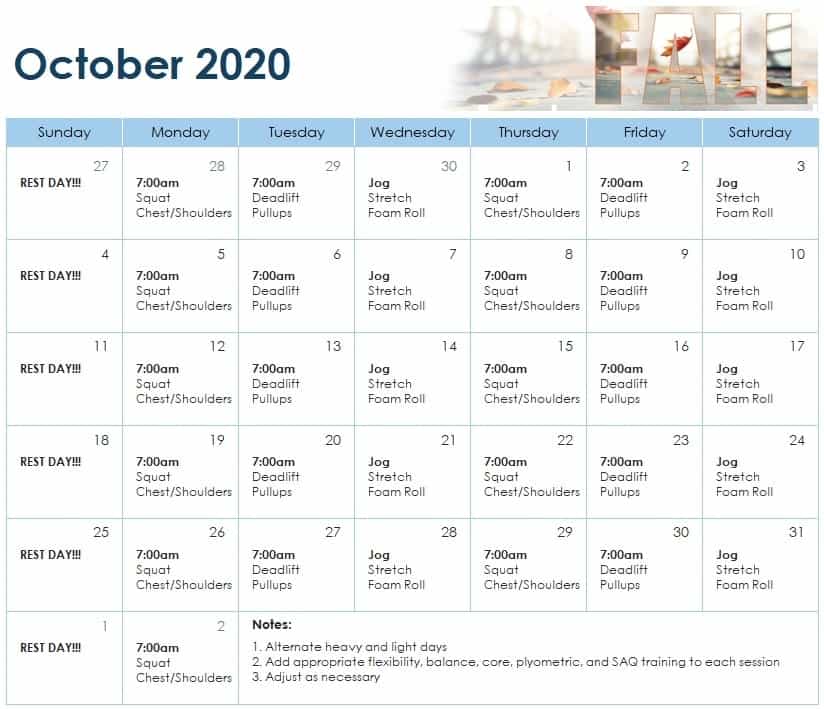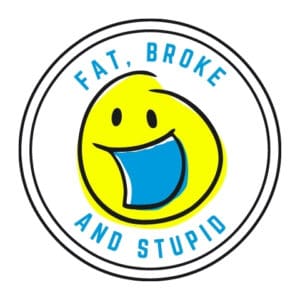
I am a complete pull up beginner! Only very recently did I successfully complete my first unassisted pull up in my life, and my form was questionable at best. I’m 34 years old, by the way.
I wanted to change that!
It all started on October 1, 2020 when I did my first unassisted pull up and committed to my plan. By October 31, 2020, and after a full month of full-body training, I was able to do 4 consecutive, unassisted pull ups!
That’s a 300% pull up increase in a month. This is how I did it…
How I Improved My Pull Ups by 300% in 30 Days
To improve my pull ups, I decided that a total body approach that was holistic and maintainable over the long term would be best.
I worked on ALL of these things to improve my pull ups, not just doing pull ups every day:
1. Weight Loss
Performing pull ups requires moving your body weight. The more you weigh, the stronger you need to be to perform a repetition. Losing excess body weight while maintaining, or improving, your strength makes it easier to do a pull up.
I lost about 3.5 lb. (1.6 kg) this month. It may not sound like a lot, but every bit helps. And when you consider that I lost weight while getting stronger, you can see how powerful weight loss can be to improving your pull ups.

2. Hand Position
There are essentially three different grips you can choose from when doing a pull up:
- Narrow Grip
- Shoulder Width Grip
- Wide Grip
The best option for maximizing and improving your pull ups is to grip the bar slightly wider than shoulder width.
This positioning places your shoulders in the proper position to get your elbows out in front of your body. This allows you to get more power from your latissimus dorsi muscles (your “lats”), which should be the prime movers of the movement and the main source of strength and power pulling you up to the bar.
When I started, my hand positioning was wider than it should have been. I moved my hand position in a bit to just outside my shoulder width, and this contributed to improving my pullups.

3. Pull Up Form
Form is just as important, if not more important, than strength when performing a pull up.
Firstly, you can get hurt performing pull ups. Proper form reduces (but does not eliminate) the possibility of hurting yourself.
Secondly, proper pull up form allows you to do more pull ups during any given set, which is my goal. Unfortunately, when you see people doing pull ups, they may not always be using ideal form.
Here are some things to consider:
- Leg straight and slightly forward
- Toes pointing downward
- Calves engaged
- Quads engaged
- Glutes engaged
- Abs engaged
- Stay stable (Don’t swing)
- Hang actively with scapula retracted
- Look at the bar before initiating the movement
- Hands are gripping slightly wider than shoulder width apart
- Pull until your chin passes the bar
There is a lot to consider when doing a “simple” pull up, more than I listed here, and performing one rep with correct form is really challenging. It’s one of the things that makes pull ups so difficult to begin with.
When I started, my form was horrible. Now, it has improved to just being bad. Over time, I hope to advance my pull up form to the satisfactory level and beyond. It’s a work in progress, and an important aspect which should not be overlooked!
To learn more about how to properly perform a pull up, watch this video by Jeff Cavaliere at ATHLEAN-X on YouTube: The Official Pull-up Checklist (AVOID MISTAKES!) I learned much of what I know by binge watching all of his pull up videos, and I reference and source his video content often in this article.
4. Full Body Training
Performing many pull ups requires more than just strong back muscles. It also requires:
- strong abs and core muscles.
- having a strong deadlift.
- having scapular strength.
- having grip strength.
- balance and stability.
I am only as strong as my weakest link, so to perform more pull ups I will need to improve my entire body.
Additionally, if I only worked on pull ups, I would run the risk of developing imbalances in my body which could lead to injury… pretty much like it did with my 100 Pushups a Day for a Year challenge!
Lastly, my fitness goals go beyond just being able to do more pull ups. I want a healthy, strong, aesthetic body. That requires training all of the different muscle groups, not to mention stretching, flexibility, balance, cardio, and rest.
It is true that my focus is on pull ups at the moment, but I do not want my gains to come at the cost of a healthy body.
5. Consistent Training
Consistency is key when it comes to making progress with your health and fitness. Stopping and starting leads nowhere in the long term.
I recently became a Certified Personal Trainer through the National Academy of Sports Medicine (NASM), so I made my own training routine for the entire month that would be challenging, but achievable, for me.
I planned my routine in advance, I wrote it down, and I did it every single day. This type of planning, consistency, and execution was yet another key to my success.
6. Rest and Recovery
Rest and recovery are very important for making strength gains and gains in muscle size. In the past, I failed at allowing myself enough time to rest and recover between workouts.
This time, however, I made sure to give myself one complete rest day each week. I also staggered my training so that I would exercise each muscle group (legs, back, chest, shoulders) only twice a week. This allowed me to be to rested and ready to go each workout, and to really give it my best.
Additionally, I made sure to get plenty of sleep and to eat good, healthy, and nutritious food to supply my body with all of the fuel it needed to properly recover. I supplemented my diet with an additional 20-40 grams of protein powder each day.
7. Newbie Gains
Since I am so new to pull ups, my body and central nervous system were never used to performing this movement pattern.
This month, however, my body was forced to quickly react to all of the new training I was doing. My body reacted by getting stronger and by getting better at performing the movements that I regularly asked it to do.
This quick reaction can also be considered as Newbie Gains. They may last a little longer, but at some point, my body will have adapted to the pull up movement pattern and will be strong enough to cope with the stress I am regularly placing on it. At that point, gains will be harder to come by.
But until then, I’m enjoying the ride!
My Pull Up Training Routine
Here is the routine I designed for myself:
- Mondays and Thursdays – Squats, Bench Press, Shoulder Press
- Tuesdays and Fridays – Deadlifts, Pull Ups
- Wednesdays and Saturdays – Jogging (Cardio)
- Sundays – Total Rest Day!
I focused my lifting on compound movements to get more bang-for-my-buck. I alternated muscle groups in each training session. I only trained each muscle group twice a week, with one day focusing on lifting heavy and the 2nd day focusing on lifting light with more repetitions. I added in some cardio. I did some, albeit limited, core work in the form of planks. I took one rest day per week.
That’s pretty much it.
I must say that I also did a lot of flexibility training in the form of static stretching and foam rolling this month. It helped me recover more quickly and have less pain following my workouts.
Here is a downloadable copy of my exact workout for you to have should you wish to try my workout for yourself this month. Make sure to click the tab for October!

How to Start Doing Pull Ups When You Can’t Do Pull Ups
You might be wondering how I trained my pull ups if I was only able to do one when I started!
Great question! I primarily used these two training techniques:
- Assisted Pull Up Bands – they took some of the weight off of my body, allowing me to perform more reps at a time. I have four bands of varying resistances. I used all four at the same time when I started. Now, I only use two.
- Pull Up Negatives – Negatives focus on the eccentric, or downward, part of the movement. They are great for building strength, especially when you are a beginner. Be warned: negatives cause more muscle damage than the concentric, or upward, part of the pull up. If you are not used to doing negatives, they can leave you quite sore for the next day or two until your body gets stronger. Still, they are a great technique for improving all of your lifts.
And of course, strengthening my entire body with my well-rounded, consistent training helped, too!
How Many Pull Ups Should I Be Able to Do?
According to John Sifferman of the Physical Living website, there are too many sources of conflicting information to know how many pull ups the average man and woman can, or should, be able to perform.
To the best of his ability, he has concluded that adults should be able to perform the following number of pull ups:
- Men – should be able to perform 8 pull ups
- Women – should be able to perform 1-3 pull ups
While going from 1 to 4 pull ups in a month was great, it would seem that I still have a way to go before meeting these fitness standards.
According to John Sifferman’s Totally Unofficial Pull-up Standards, my performance went from Newbie to Beginner!
Here are his standards for men doing a strict, dead-hang pull up, which I am quoting directly from his website:
- Newbie = 1st unassisted pull-up [DONE]
- Beginner = 2-5 repetitions [DONE]
- Intermediate = 6-10 repetitions
- Advanced = 11-15 repetitions
- Expert = 16-20 repetitions
- Master = 21-25 repetitions
- Wicked Sick = 26-30 repetitions
- Superhuman = 30+ repetitions
- Olympian = 40+ repetitions
- Pull-up Immortal = 50+ repetitions
John Sifferman literally wrote the book on pull up training. It’s called The Pull-up Solution: The Complete Pull-up and Chin-up Training System. Click the link to check it out and learn a whole bunch more about improving your pull ups!!!
Thanks for your awesome resource, John!
What Is My Current Pull Up Level Based on My Weight?
The Strength Level website has a really cool resource comparing your weight to the maximum number of pull ups you can perform to failure in one set.
I currently weight about 185 lbs. (I used to weigh 296 lbs.! Find out How I Lost Over 100 lbs. and Kept it Off for Years!)
Based on these standards, a man weighing between 180 to 190 lbs. will have these levels:
| Bodyweight | Beginner | Novice | Intermediate | Advanced | Elite |
| 180 lbs. | < 1 rep | 6 reps | 13 reps | 22 reps | 31 reps |
| 190 lbs. | < 1 rep | 6 reps | 12 reps | 21 reps | 30 reps |
As you can see, I started as a beginner and remain a beginner. To be honest, this seems fair. I have only just begun training pull ups. To be anything other than still a beginner would we very ambitious, if not simply wishful thinking.
Check out the chart for yourself and find out what your pull up level is based on these standards!

Why I Did NOT Do 100 Pull Ups Every Day for 30 Days
In the past when I wanted to improve my pushups (not pull ups), I did 100 pushups a day for an entire year. At the time, it seemed like a great idea.
There were some serious problems with that 100 pushups a day challenge. Among other things:
- It was too hard at the beginning.
- It was too easy at the end.
- It was unbalanced – too much pushing with not enough pulling.
- My legs and lower body went largely untrained.
- There was too little rest between training sessions.
- Really, there was no rest at all.
- I didn’t stretch enough.
- I did not train my chest in any other way other than pushups.
- I suffered a minor injury 10 days before finishing the challenge!
Needless to say, I learned my lesson.
On top of that, I was only capable of doing one pull up on my 1st day. In comparison, I did 17 pushups on my 1st day training pushups. It would have been almost impossible to complete 100 pull ups in a day, let alone for 30 days in a row, even if I wanted to.
You can read all about that in another article I wrote: I Did 100 Pushups a Day for a YEAR (The Good, Bad, and UGLY!
Pull Ups for Beginners Like Me
If you are a beginner like me, I’ll be honest and say that pull ups are challenging. I find them to be much more challenging than pushups.
Still, if I can make improvements, so can you!
You have seen exactly what I did to achieve my results, and there are lots of other great pull up training programs out there to choose from. Find one that works best for you (feel free to use mine) and commit to it!
There may be some ups-and-downs along the way (Yes, pun intended!) but with commitment and consistency, you will be better at pull ups in the future than you are today.
Jack Clancy YouTube Channel
You have read the article, now be sure to head on over to my Jack Clancy YouTube Channel and see my pull up results for yourself!
PRO TIP: If you watch the video and hit the LIKE button, you will instantly be able to do one additional pull ups. That’s a fact!
Thank you for reading my article and supporting my work-passion. I deeply appreciate it. I wish you all the best on your health and fitness journey.
Now, go crush some pull ups!
Jack

